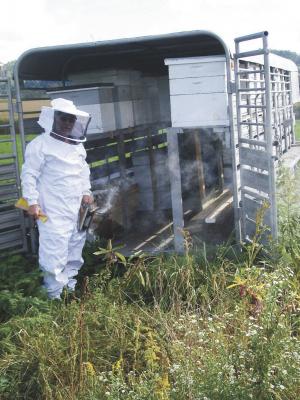2014 - Volume #38, Issue #1, Page #34
[ Sample Stories From This Issue | List of All Stories In This Issue | Print this story
| Read this issue]
He Set Up A Bee Motel On Wheels
 |
The Pilot, Va., beekeeper credits beef producer Larry Knowles for giving him the idea. To protect his hives from bear, fox, skunks and other critters, Alderman first tried installing as many as six strands of electric fence around groups of hives. Sometimes, bears still manage to reach over the fence and ruin them, he says.
He had no predator problems with the hives he set up in a trailer last year. He got a reasonable deal on a 1971 cattle trailer that needed a new floor. After hiring a welder to replace the cross beams, he sawed lumber for the flooring and built a set of shelves on both sides. The 20-ft. gooseneck trailer holds up to 40 hives–10 on the floor on each side and 10 on each of the shelves. A center aisle gives him access to all the hives, which have spaces between them for bees to move around. Bees use the existing openings in the sides of the trailer, and Alderman cut additional openings lower down on the sides for bees in the bottom hives.
He sanded and painted the inside and outside with paint used on mobile home trailers to keep them cooler.
“It was cooler working those bees in the trailer than the other hives in the shade,” Alderman says. “And it sat in the sun.”
Not having to move hives was also easier on his back and knees, he adds. To harvest honey, he pulled out the supers, moved them out of the trailer on a cart, took the honey out, then replaced them. He didn’t notice any difference of honey quality or quantity compared to hives outside on the ground.
In addition to collecting honey, Alderman rents out his boxes for pollinating crops. With the hives on wheels, he plans to double crop them this year–first in orchards and then for crops. Instead of loading and unloading, he can just drive away. During the winter, he parks the trailer of hives next to a barn for wind protection.
The bee trailer drew a lot of attention last year, and Alderman, a self-taught beekeeper for 14 years, says he hopes to modify a couple more trailers for this season.
He offers advice for other beekeepers interested in trying the idea.
“Have a level place to park the trailer,” he says. “The other thing is I move all my bees at night. I don’t close the entrance to move them.”
He also suggests posting warnings to stay 500 ft. away from the trailer for liability purposes. Plus he locks the trailer to avoid problems from two-legged predators.
Alderman will be busy this winter modifying trailers and building his own hives out of cedar to deter moths from invading his hives. He appreciates the help he receives from Larry’s father, Walter, 84, who is in a motorized chair and helps build most parts of the beehives and puts the foundation wax in the frames. Alderman adds he is willing to talk to other beekeepers and share his experience.
He only has one complaint about his trailer hives. The bees tend to only go outside and not inside the trailer. So when he works the hives he doesn’t get stung very often.
That’s bad, he says, because he has arthritis, and the stings help relieve it.
Contact: FARM SHOW Followup, Daryl Alderman, 4435 Old Pike Rd., Pilot, Va. 24138 (ph 540 382-5203).

Click here to view page story appeared in

Click here to read entire issue
To read the rest of this story, download this issue below or click here to register with your account number.




